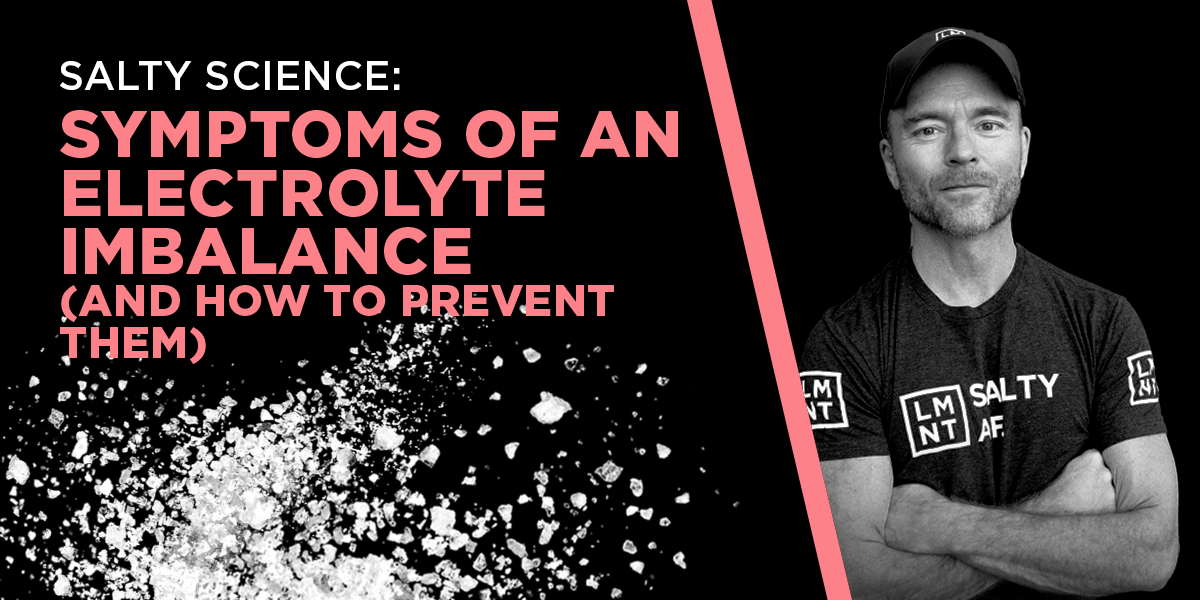Do you have symptoms of an electrolyte imbalance? To find out, some detective work may be required.
First of all, different electrolyte disturbances have different symptoms. (If they present with symptoms at all.) A sodium imbalance presents differently from a calcium imbalance, and both are distinct from a magnesium imbalance.
To complicate matters further, the symptoms often overlap. For instance, low sodium, potassium, magnesium, or calcium levels can all cause muscle cramps. Which disturbance is causing your muscle cramps? That’s where your sleuthing comes in.
Do you sweat like a country hog and rehydrate with plain water? It’s probably low sodium. Are you on proton pump inhibitors for acid reflux? Could be low magnesium. Do you have diarrhea? Diarrhea depletes potassium levels faster than your dog vacuums up fallen food.
You’ll notice that I’m not discussing dietary electrolytes. Dietary electrolytes do matter, but they’re rarely the sole cause of an electrolyte imbalance. This is a crucial point. It’s also a point of mass confusion, and I’ll untangle this confusion later.
Lastly, it’s crucial to remember that dietary electrolytes won’t necessarily prevent an electrolyte imbalance. They can help prevent these disturbances, but other factors like kidney function, medications, hydration habits, and various medical conditions are more relevant.
By the end of this article, you’ll understand the causes, symptoms, and remedies for the major electrolyte imbalances. Let’s dive in, shall we?
What is an Electrolyte Imbalance?
An electrolyte imbalance is a disturbance in the concentration of electrolytes in your body. Specifically, an electrolyte imbalance occurs when blood levels of a given electrolyte become too low or too high.
Each electrolyte—sodium, chloride, potassium, magnesium, calcium, phosphate, and bicarbonate—serves important functions in your blood and tissues. These functions include:
- Regulating nerve transmission
- Mediating fluid balance
- Promoting proper heart function (heartbeat)
- Facilitating cellular signaling
- Controlling muscle contraction
- Influencing immunity
- Maintaining hormonal health
- And much more
When electrolyte levels depart from normal ranges, these functions are disrupted. Electrolyte imbalance symptoms often follow.
These symptoms can range from mild (muscle cramps, low energy, fatigue, irritability) to moderate (muscle spasms, muscle weakness, lethargy, confusion) to severe (seizures, brain damage, disturbances in heart rhythm, and death). Unsurprisingly, electrolyte disturbances often require medical attention.
What causes an electrolyte imbalance? That depends on the electrolyte, but it generally involves poor kidney function, illness, or diuretic medications.
Later, I’ll double click on the symptoms and causes of an electrolyte imbalance. First, though, I want to distinguish between imbalances and deficiencies.
Electrolyte Imbalance vs. Electrolyte Deficiency
When someone has an electrolyte imbalance, blood levels of that electrolyte are too low or too high. It shows up on a lab test, and the person may require medical treatment.
But when someone consumes insufficient electrolytes for optimal health, that’s an electrolyte deficiency, and it won’t show up on a blood test. Blood electrolyte levels, in other words, tell you little about dietary electrolyte status.
How can this be? If you under-consume electrolytes, shouldn’t blood levels fall? It seems logical, but your body won’t let it happen. It won’t let it happen because serum electrolyte levels are priority number one. Basic cellular functions depend on it.
Your body works tirelessly to maintain serum electrolytes. For example, it secretes hormones like aldosterone, renin, angiotensin, and norepinephrine that curb sodium losses. These hormones ALSO elevate blood pressure, but your body doesn’t care. That’s long-term heart health stuff. Retaining sodium is the priority.
Your body also doesn’t care about bone health. Not as much as serum electrolytes, anyway. When serum electrolytes fall, your body starts excavating bone like it’s the gold rush of 1849. The “gold”, in this case, is the sodium, potassium, calcium, and magnesium stored in your skeleton. Should we be surprised that deficiencies in each of these minerals are linked to osteoporosis?[*][*][*][*] The question all but answers itself.
But again, these deficiencies DO NOT cause an electrolyte imbalance. Not alone. Electrolyte imbalances are rare in folks with healthy kidneys—the key organs in the electrolyte maintenance system.
What actually causes electrolyte imbalance, then? And what symptoms should you watch for? Keep reading.
Sodium Imbalance: Symptoms and Causes
Heard of hyponatremia? I’ve spent an absurd amount of time thinking, writing, and worrying about this dangerous state of low serum sodium.
The main causes of hyponatremia are kidney failure, heart failure, liver disease, cancer, vomiting, diarrhea, diuretic usage, and overhydration with plain water. Drinking too much plain water is super dangerous, especially for elite athletes. Many have perished, and many more have suffered debilitating symptoms.
But non-competitors can develop milder cases of exercise-associated hyponatremia too. If you’re not replacing sweat losses with water plus sodium, you’re at risk. I speak from experience.
Symptoms of mild hyponatremia include muscle cramps, fatigue, mood swings, brain fog, low energy, and feeling “off.” As sodium levels continue to fall, the person may experience:
- Confusion
- Light sensitivity
- Seizures
- Loss of consciousness
- Extreme lethargy
- Brain swelling
- Brain damage
- Death
Hypernatremia (high serum sodium), on the other hand, is generally a problem for elderly folks with fluid access and thirst issues. The symptoms of hypernatremia are similar to those of dehydration: cramps, thirst, irritability, dry skin, and dark urine.
Potassium Imbalance: Symptoms and Causes
If you’re suffering from low potassium, it was probably caused by diarrhea, diuretics, laxatives, or kidney issues. It’s not because you didn’t eat enough potassium-rich foods.
The symptoms of low potassium (hypokalemia) include:
- Cardiac arrhythmias
- Slow heart rate
- Brain damage
- Blood sugar dysregulation
- Muscle paralysis
The symptoms of hyperkalemia (high potassium levels) are similar. Hyperkalemia is typically caused by severe injury, chronic kidney disease, or certain medications.
Magnesium Imbalance: Symptoms and Causes
About 2% of the general population has hypomagnesemia. Low serum magnesium is much more common (10-20%) in hospitalized patients with unhealthy kidneys.
Accordingly, the main causes of hypomagnesemia are kidney failure, chronic gut illness, pancreatitis, various medications, refeeding syndrome, alcoholism, and hungry bone syndrome. And the symptoms of hypomagnesemia include:
- Tremors
- Muscle cramps, spasms, or weakness
- Seizures
- Delirium
- Lethargy
- Coma
- Heart arrhythmias
- Changes in heart function (seen on an electrocardiogram)
- Insufficient blood supply to the heart (cardiac ischemia)
Moving on, hypermagnesemia (high serum magnesium) can cause weakness, nausea, dizziness, confusion, or altered heartbeat. It often results from impaired kidney function combined with high doses of supplemental magnesium.
Calcium Imbalance: Symptoms and Causes
There are two types of calcium imbalance:
- Hypocalcemia (low serum calcium)
- Hypercalcemia (high serum calcium)
Both are problematic. Hypocalcemia is generally caused by kidney failure or vitamin D deficiency—and the symptoms include muscle spasms, anxiety, depression, seizures, and irregular heartbeat. It’s less common than hypercalcemia, but can be fatal if not promptly treated.
Hypercalcemia affects 1-2% of the population and usually results from excess parathyroid hormone (PTH) production, vitamin D toxicity, or certain cancers. The symptoms of hypercalcemia include heart dysrhythmia, bone pain, nausea, fatigue, confusion, constipation, kidney stones, and soft tissue calcification.
What about calcium supplements? In higher doses, calcium pills provoke a state of temporary hypercalcemia that can cause blood vessels to calcify. This may be why calcium supplements have been linked to higher heart disease risk, and it’s why I don’t include calcium in LMNT.
Phosphorus Imbalance: Symptoms and Causes
I also don’t include phosphorus in LMNT. Why? Because most people get too much (not too little) phosphorus in their diet, and excess phosphorus is bad news for bone density.
As with the other imbalances, a phosphate imbalance is typically caused by kidney issues, drugs, or diuresis. Interestingly, most patients with hyperphosphatemia (high phosphate levels) and hypophosphatemia (low phosphate levels) are asymptomatic.
Refeeding syndrome can also cause low phosphate levels. After prolonged malnutrition, the body wants to rebuild tissues—and so following the refeed, it pulls phosphate out of the serum and into cells. Then phosphate levels plummet and the person needs critical care.
This happened to the famous magician David Blaine after 44 days of fasting in a plexiglass box. He was hospitalized for weeks following the stunt.
How To Prevent Electrolyte Imbalances
For general health, you can’t go wrong with a mineral-rich diet. This means consuming electrolyte-rich foods like dark leafy greens and vigorously salting your meals, even if you may get a few concerned looks at the family dinner table.
To be clear, this won’t make you immune to electrolyte disturbances. But it will reduce the risk of them occurring.
Another practical step is to avoid overhydration with plain water. Simply drink to thirst and add salt to water when replacing sweat losses. That’s a simple formula for preventing hyponatremia.
But beyond hyponatremia, electrolyte imbalances aren’t usually so simple. Rather, they’re an unfortunate consequence of kidney issues, heart issues, medications, or chronic illness.
If you’re dealing with any of these factors, you may need special treatment. (Supplementation, shifting your medicinal protocol, fixing the underlying issue, etc.) This is something to discuss with your medical professional.
Understand that it may take some investigation to determine what’s going on. Once you know what you’re dealing with, you’ll be in a better position to handle it.

